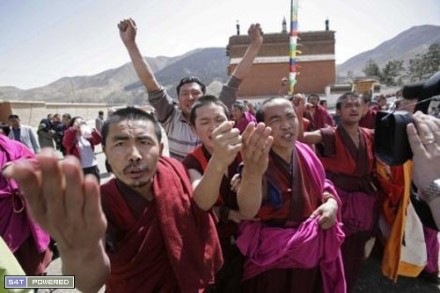
Sangay took leading role in the peaceful protests that occurred in Labrang in Tibet’s northeastern Amdo Province in 2008. Defying intense restriction by the Chinese government on 4 April 2008, he and his colleagues from Labrang Monastery spoke to a group of visiting foreign journalists about the “suppression of fundamental human rights in Tibet by the Chinese government”.
Fearing arrest by the Chinese government he fled and spent more than a year in hills facing insurmountable hardships. Lack of proper food compounded by mental trauma left him debilitated and bedridden. Every possible help to recover him through medication by his family and relatives failed and his health condition grew bad to worse. He was eventually admitted to a hospital in Siling and as there was not much improvement in his health, he had to undergo a surgery in another hospital. Ironically, the Chinese government did not arrest him after knowing that there was no hope of his recovery. Even the hospital discharged him for the same reason.
Sangay spent his remaining days in his home and passed away on 26 February 2011. He is survived by his old parents, both of whom are above 70 years old.
Sangay was born in 1969 in a nomadic family in Labrang Tashikhyil. He was ordained at the age of 16 and began his religious studies at Labrang Monastery. In 1991 he went to Drepung Loseling Monastery in India to pursue his studies. Unfortunately, he had to return to Tibet to continue his studies as his health could not adapt to the environment in India.
Like Sangay Gyatso, many Tibetans living in Tibet are forced to leave their homes for hills to escape torture by the Chinese authorities. The death of Sangay Gyatso has reinforced the danger to the lives of many Tibetans who are losing their strength to live in insuperable harsh circumstances.
An estimated 227 Tibetans have died under China’s crackdown since March 2008, out of which 153 could be identified. The deaths were caused by to indiscriminate firing by the PRC forces during the demonstrations; severe beatings and torture of detainees during arrest, interrogation and detention; and a built-up of insurmountable repression and suppression that drove some Tibetans to commit suicide. One death was caused either by starvation or suicide in the initial phase of the March 2008 protests when the major monasteries were sealed off and closed for days. (Read 2008 uprising in Tibet: Chronology and Analysis]
Over 6,810 Tibetans have been arrested and detained and at least 510 Tibetans sentenced since 10 March 2008. The judicial process was devoid of fair trial and independent legal representation.
A total of seven Tibetans have been sentenced to death since then – two with immediate death sentence who were subsequently executed and five are currently facing suspended death sentence or death sentence with a two-year reprieve. All defendants are young Tibetans below the age of 30. Lobsang Gyaltsen and Loyak, both 25-year-old, were executed on 20 October 2009. The other five facing suspended death sentences are Tenzin Phuntsok, 27; Kangtsuk, 22; Penkyi, 21; Pema Yeshi, 28; and 23-year-old Sonam Tsering.
